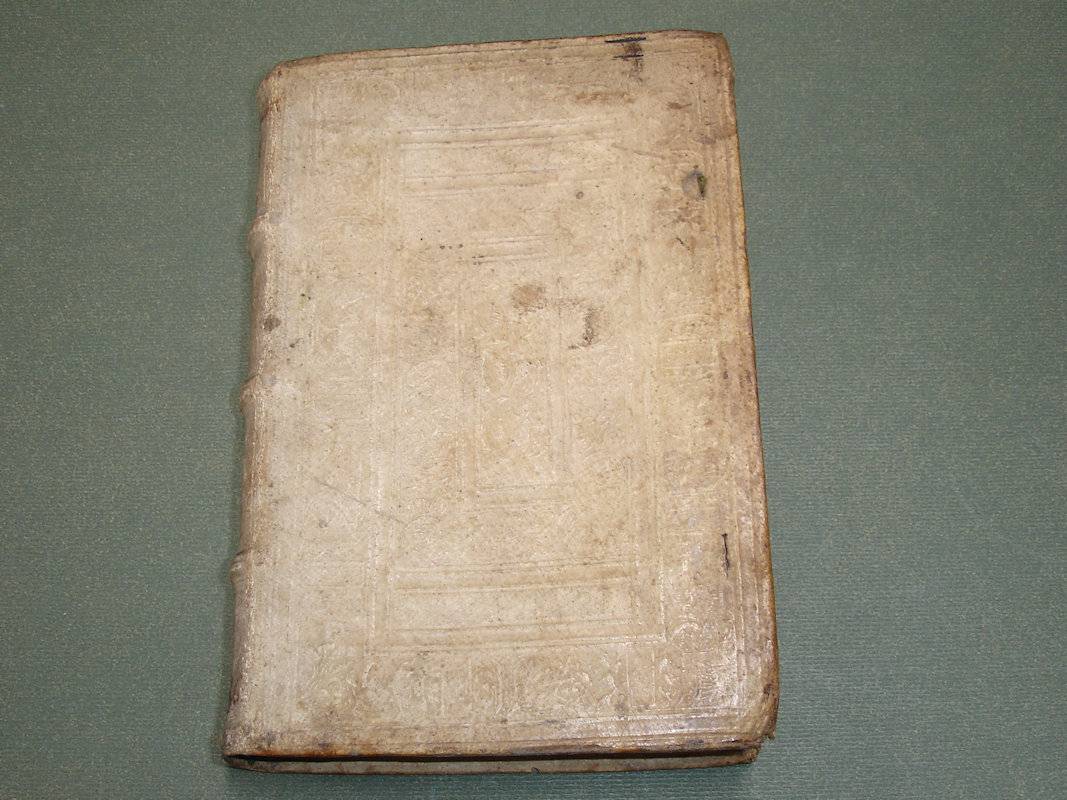SOPHOCLES.- CAMERARIUS,J.
Commentatio explicationum omnium tragoediarum Sophoclis, cum exemplo duplicis conversionis Ioachimi Camerarii Pabepergensis. Accessit rerum & verborum in his praecipue notatu dignarum copiosus index. Cum Caes. ac Regiae Maiestratum gratia & privilegio ad annos decem.
Basel (Basileae), per Ioannem Oporinum, 1556. (Colophon at the end: 'Basileae, Ex Officina Ioannis Oporini, Anno Salutis humanae 1556, mense Augusto)
8vo. 515,(37 index) p. Pigskin over wooden boards. 19 cm (
Ref: VD16 S 7043; GG (Griechischer Geist aus Basler Presse) 203; Hoffmann 3,424; Moss 2,605 (with the incorrect date 1534); Graesse 6/1,442) (
Details: Back with 3 raised bands. Boards decorated with 2 rows of blind-stamped rolls, both comprising floral motives and small portraits of biblical figures, e.g. King David, (harp) and portraits of Renaissance scholars, e.g. Erasmus; some portraits are accompanied by short texts which are difficult to decipher, e.g. 'Ecce Agnus Dei'. Some woodcut initials. Good paper) (
Condition: Binding soiled and scuffed. Corners bumped. All four ties gone. A few small wear holes in the front flyleaf. Very tiny hole at the lower edge of the title. Small wormhole at the tip of the uppercorner of the last gathering. Ownership entries on the front pastedown and flyleaf) (
Note: The tragic heroes of the Greek tragedian Sophocles, ca. 496-406/05 B.C, Oedipus, Antigone, Electra, Heracles, Ajax, Philoctetes, have 'inspired artists, thinkers, and performers both ancient and modern to refashion them and their stories again and again'. (The Classical Tradition, Cambr. Mass., 2010, p. 897) Especially through his three Theban plays, Antigione, Oedipus Rex and Oedipus Coloneus, Sophocles has had his greatest influence on Western culture. 'Aristotle prized Oedipus the King as the model for all tragic drama, and from the Renaissance onward the influence of his Poetics established this as conventional wisdom.' (Op. cit., ibidem) § While the West was ignorant of the works of the tragic poets during the Middle Ages, the surviving tragedies of Aeschylus, Sophocles and Euripides were edited during the Palaeologean Renaissance, the last phase of Byzantine art and scholarship, by the philologists Maximos Planudes (ca. 1250-1310), Thomas Magister (ca. 1270-1325), Manuel Moschopoulos (ca. 1265-1315), and his pupil Demetrios Triklinios (ca. 1280-1340). Their editions were the source for the printed editions of the 15th century. In 1534 the German scholar Joachim Camerarius published an edition with commentary. Camerarius was born in 1500 in Bamberg. He died in Leipzig in 1574. He held classical professorships at Nürnberg, Tübingen and Leipzig, and was one of the most significant representatives of Renaissance humanism in the Reformation. His interests were diverse and his productivity spectacular. 'His numerous editions of the Classics, without attaining the highest rank, are characterised by acumen en good taste. They include Homer, the Greek elegiac poets, Theocritus, Sophocles, Thucydides and Herodotus'. In critical acumen Camerarius 'holds one of the foremost places among the German scholars of the sixteenth century'. (J.E. Sandys, 'A history of classical scholarship', N.Y., 1964, p. 266/67) He also wrote poetry, produced biographies of famous contemporaries, and wrote on church history, theology and paedagogy. This work of Camerarius of 1556 contains a commentary to the seven plays of Sophocles. It offers also two Latin translations, of the Aias and the Electra, one 'ad verbum', and one more free. In the 'prolegomena' Camerarius discusses the intentions of the poet (De consilio autoris), the genre (De genere scripti), and biographic matters (De autore harum Tragoediarum). Each play is preceded by an extensive survey of the content (Argumentum). At the end is a mixed Greek and Latin index. On the last page a Greek poem of the humanist Karolos Outhenôbios (Utenhove) on the printer/scholar Oporinus. In the introductory letter Camerarius tells us that, knowing that Vitus Ortelius Winsemius had already published a Latin translation of the complete works of Sophocles (1546), he decided to offer a translation of only 2 plays, to explain his aim. 'Et existimo studiosis utriusque linguae hunc laborem nostrum ad proprii e puri sermonis cognitionem, nonnihil adiumenti esse allaturum'. (Epistola p. 4)) (
Provenance: In old ink on flyleaf: 'Elucidarium hunc Sophocleum e manu amicissimi mei Pauli Ortelii.Plavensis ad invidiam usque munificâ accepi P.trachias (?) Spradlerij, 1638, Die 19 Decembris'; Much is uncertain concerning this provenance. Plavensis is 'from Plauen' a city in Sachsen. Ortelii seems legible, so is the first name of the receiver Spradler'. § On the front pastedown in ink: 'Ex Bibliotheca Scholae Grypeswaldensis', above this the oval stamp 'Lehrer-Bibliothek des Gymnasiums zu Greifswald'. § On the front pastedown in pencil: 'Sept,. 1964', written by the Flemish linguist Walter Couvreur, 1914-1996, who was an Orientalist, and professor of Indoeuropean linguistics at the University of Gent. It indicates the date of aquisition. The place of acquisition he wrote on the flyleaf at the end: 'Zentralantiquariat, Leipzig') (
Collation: a-z8; A-L8, M4) (Photographs on request)
Book number: 130160 Euro 950.00
Keywords: (Oude Druk), (Rare Books), Camerarius, Greek literature, Griechische Literatur, Latin translation, Sophocles, Swiss imprints, Tragödie, antike altertum antiquity, tragedy
 SOPHOCLES. CAMERARIUS,J.
SOPHOCLES. CAMERARIUS,J.

